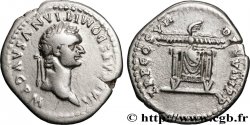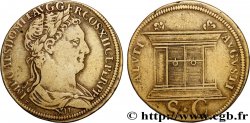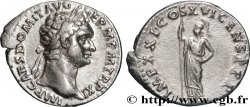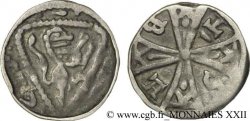bpv_304975 - DOMITIANUS Tétradrachme syro-phénicien
Nicht verfügbar.
Artikel auf unserem Online-Shop verkauft (2013)
Preis : 95.00 €
Artikel auf unserem Online-Shop verkauft (2013)
Preis : 95.00 €
Type : Tétradrachme syro-phénicien
Datum: 82-83
Name der Münzstätte / Stadt : Antioche, Syrie, Séleucie et Piérie
Metall : Silber
Durchmesser : 26,00 mm
Stempelstellung : 12 h.
Gewicht : 14,36 g.
Kommentare zum Erhaltungszustand:
Usure de circulation, limitée aux lauriers du droit et décentré à l’avers, style caractéristique de “l’école alexandrine”
N° im Nachschlagewerk :
Pedigree :
Cet exemplaire est le 0143_052 de la base TSP
Vorderseite
Beschreibung Vorderseite Tête laurée de Domitien à droite avec l’égide ancienne, à la peau de chèvre et au serpent, autour du cou.
Legende des Averses AUTOK KAISAR DOMITIANOS
Übersetzung der Vorderseite (l’empereur césar Domitien).
Rückseite
Beschreibung Rückseite Aigle debout à droite sur un foudre, les ailes déployées ; dans le champ à droite une palme posée verticalement.
Legende des Reverses : ETOUS NEOU IEROU B
Übersetzung der Rückseite (année sacrée deuxième du règne).
Kommentare
Nous avons déjà remarqué à propos de la première émission de Vespasien que, curieusement, ce qui se rapproche le plus du type de la première année de frappe de Domitien, caractérisée par un aigle sur foudre à droite avec l’égide ancienne, ce sont aussi bien les émissions du milieu du règne de Néron (Prieur 84 à 89), antérieures d’une vingtaine d’années, que les premières émissions du règne de Vespasien (Prieur 103 à 105), frappées dix ans avant. Faut-il en déduire qu’il était politique à Antioche, pour un nouvel empereur du premier siècle, de rappeler le souvenir de ces frappes de Néron ? L’aegis si particulière qui les caractérise (dite ancienne et se composant apparemment d’une peau de chèvre et d’un serpent, sans rapport direct avec l’aegis normale, ornement de poitrine rappelant la Méduse) avait-elle une signification particulière pour les Antiochéens ? Si tel est le cas, son identification, si elle peut être confirmée, renvoie au culte de Zeus, comme l’aigle et le foudre. Pourtant, le principal culte d’Antioche semble avoir été dédié à Apollon...
Dans le cas de Domitien, et contrairement aux frappes de son père, l’aigle sur le foudre restera le type de revers pour tout le règne mais l’égide disparaitra dès la deuxième émission, celle de l’an 7, passée.
On constate par ailleurs que les frappes de l’an 2 de Domitien avaient probablement un motif plus politique qu’économique : il n’avait pas été nécessaire de frapper depuis l’an 5 de Vespasien, rien pendant le règne de Titus auguste, et Domitien lui-même ne frappera plus avant l’an 7 de son règne : l’abondant numéraire fabriqué pendant la guerre contre les Juifs était manifestement encore suffisant pour la circulation monétaire.
Cinquante-cinq exemplaires sont maintenant répertoriés dans la base TSP avec, en musées, Paris (2), Berlin, Glasgow, Berne, Jérusalem, ANS et British Museum.
We have already noted with regard to the first issue of Vespasian that, curiously, what comes closest to the type of the first year of Domitian's minting, characterized by an eagle on a thunderbolt on the right with the ancient aegis, are both the issues from the middle of the reign of Nero (Prior 84 to 89), some twenty years earlier, and the first issues of the reign of Vespasian (Prior 103 to 105), minted ten years earlier.. Should we deduce from this that it was political in Antioch, for a new emperor of the first century, to recall the memory of these strikes of Nero? Did the very particular aegis which characterizes them (said to be ancient and apparently consisting of a goatskin and a snake, without direct relation to the normal aegis, a chest ornament reminiscent of Medusa) have a particular significance for the Antiochians? If this is the case, its identification, if it can be confirmed, refers to the cult of Zeus, like the eagle and the thunderbolt. Yet the main cult of Antioch seems to have been dedicated to Apollo. . .
In the case of Domitian, and unlike his father's strikes, the eagle on the thunderbolt will remain the type of reverse for the entire reign but the aegis will disappear from the second issue, that of the year 7, after.
We also note that the minting of the year 2 of Domitian probably had a more political than economic motive: it had not been necessary to mint since the year 5 of Vespasian, nothing during the reign of Titus Augustus, and Domitian himself would not mint again before the year 7 of his reign: the abundant currency produced during the war against the Jews was clearly still sufficient for monetary circulation..
Fifty-five copies are now listed in the TSP database with, in museums, Paris (2), Berlin, Glasgow, Bern, Jerusalem, ANS and the British Museum
Dans le cas de Domitien, et contrairement aux frappes de son père, l’aigle sur le foudre restera le type de revers pour tout le règne mais l’égide disparaitra dès la deuxième émission, celle de l’an 7, passée.
On constate par ailleurs que les frappes de l’an 2 de Domitien avaient probablement un motif plus politique qu’économique : il n’avait pas été nécessaire de frapper depuis l’an 5 de Vespasien, rien pendant le règne de Titus auguste, et Domitien lui-même ne frappera plus avant l’an 7 de son règne : l’abondant numéraire fabriqué pendant la guerre contre les Juifs était manifestement encore suffisant pour la circulation monétaire.
Cinquante-cinq exemplaires sont maintenant répertoriés dans la base TSP avec, en musées, Paris (2), Berlin, Glasgow, Berne, Jérusalem, ANS et British Museum.
We have already noted with regard to the first issue of Vespasian that, curiously, what comes closest to the type of the first year of Domitian's minting, characterized by an eagle on a thunderbolt on the right with the ancient aegis, are both the issues from the middle of the reign of Nero (Prior 84 to 89), some twenty years earlier, and the first issues of the reign of Vespasian (Prior 103 to 105), minted ten years earlier.. Should we deduce from this that it was political in Antioch, for a new emperor of the first century, to recall the memory of these strikes of Nero? Did the very particular aegis which characterizes them (said to be ancient and apparently consisting of a goatskin and a snake, without direct relation to the normal aegis, a chest ornament reminiscent of Medusa) have a particular significance for the Antiochians? If this is the case, its identification, if it can be confirmed, refers to the cult of Zeus, like the eagle and the thunderbolt. Yet the main cult of Antioch seems to have been dedicated to Apollo. . .
In the case of Domitian, and unlike his father's strikes, the eagle on the thunderbolt will remain the type of reverse for the entire reign but the aegis will disappear from the second issue, that of the year 7, after.
We also note that the minting of the year 2 of Domitian probably had a more political than economic motive: it had not been necessary to mint since the year 5 of Vespasian, nothing during the reign of Titus Augustus, and Domitian himself would not mint again before the year 7 of his reign: the abundant currency produced during the war against the Jews was clearly still sufficient for monetary circulation..
Fifty-five copies are now listed in the TSP database with, in museums, Paris (2), Berlin, Glasgow, Bern, Jerusalem, ANS and the British Museum








 Berichten über einen Fehler
Berichten über einen Fehler Die Seite drucken
Die Seite drucken Teilen meiner Auswahl
Teilen meiner Auswahl Stellen Sie eine Frage
Stellen Sie eine Frage Einlieferung/Verkauf
Einlieferung/Verkauf
 Details
Details















